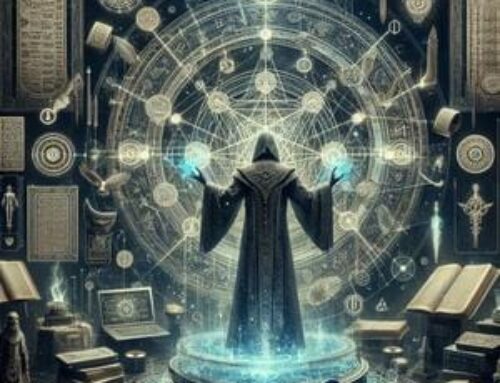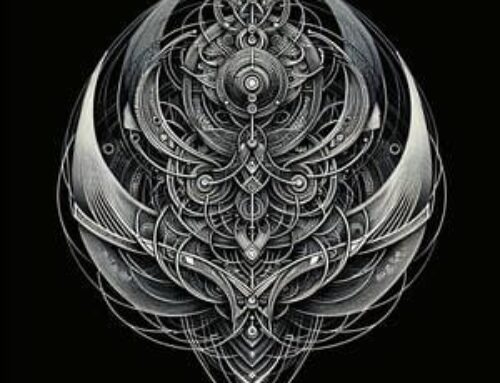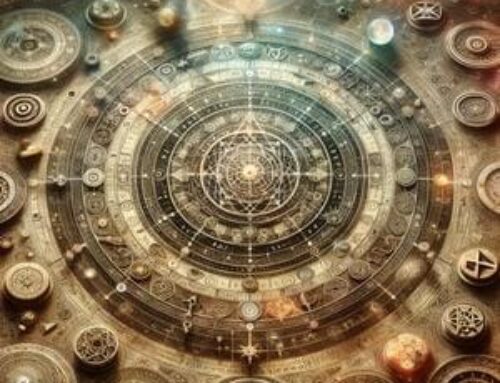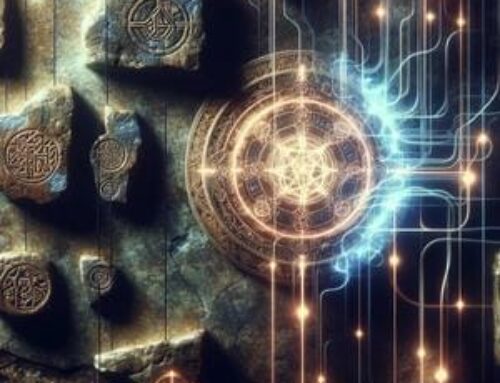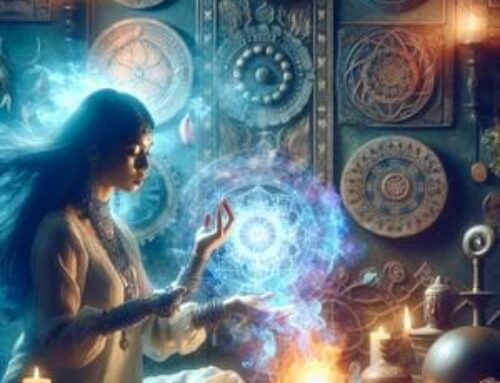Contents
- 1 Introduction to Black and White Magic
- 2 The Spiritual Dimensions of Black and White Magic
- 3 The Temptations and Risks of Black Magic
- 4 Symbolism and Archetypes in Magic
- 5 Conclusion
- 6 FAQ – Black and White Magic
- 6.1 1. What is the fundamental difference between black and white magic?
- 6.2 2. How can I ensure that my practice of magic remains ethical?
- 6.3 3. Are there specific symbols associated with white and black magic?
- 6.4 4. Can studying at the Hermetic Academy help me better understand the risks associated with magic?
- 7 References:
Introduction to Black and White Magic
In the labyrinthine corridors of esoteric study, the dualistic forces of black and white magic stand as towering pillars, each casting long shadows over the realms of the metaphysical. The journey through these arcane territories is not merely an exploration of power, but a profound dialogue between the forces of light and darkness that dwell within us all. Black and white magic, as ancient as the mystic texts that first penned their secrets, continue to bewitch and bedazzle those who seek to wield their formidable energies. Black magic is involutionary and follows the left-hand path, driven by the ego. White magic is evolutionary, aligning with the right-hand path and guided by the work of the higher self.
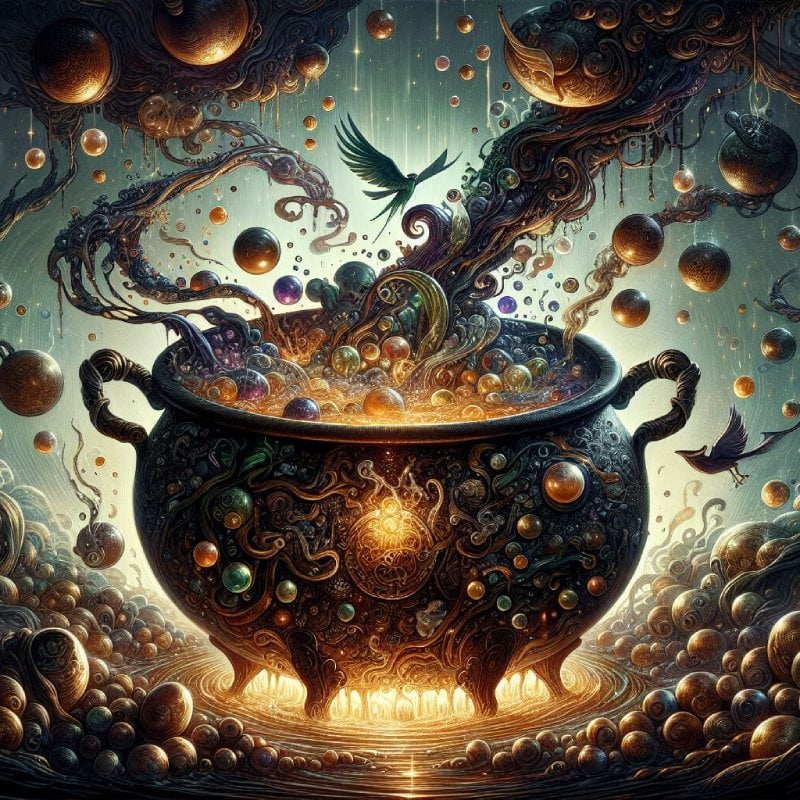
White magic, often revered for its alignment with healing, protection, and purification, serves as a beacon of spiritual ascension, guiding the soul toward the luminous realms of higher consciousness. It is here, in these elevated echelons of spiritual practice, that magic is harnessed for the greater good, fostering an environment where enlightenment is not just an aspiration but a tangible destination.
Conversely, black magic, frequently cloaked in misconceptions, conjures images of malevolent intent and dark dealings. Yet, at its core, it embodies the manipulation of energies to effect change by force, often challenging the moral compass of its practitioner. This path, fraught with peril, tests the boundaries of ethical magic, compelling its followers to gaze deep into the abyss of their desires and intentions.
The discourse on black and white magic is not a mere academic pursuit but a reflection of the perennial human struggle between virtue and vice, sacrifice and selfishness. As we delve into the philosophical and spiritual implications of these mystical practices, we uncover not only the external manifestations of magical lore but also the internal transformations they demand from those who dare to engage with the arcane. The interplay of Black and White Magic offers a vivid tableau of the mystical balance between light and shadow.
Magic is the science of the absolute… it reconciles perfectly and incontestably those two terms so opposed on the first view — faith and reason, science and belief, authority and liberty (1).
The Spiritual Dimensions of Black and White Magic
In the enigmatic world of esoteric arts, white magic serves as a conduit for the higher aspirations of the human spirit. This branch of magic, often aligned with healing, protection, and the purification of spaces and souls, adheres to a strict ethical framework that respects the free will and well-being of all beings involved.
Ethical Foundations of Black and White Magic
The practice of white magic is grounded in the principle of ‘An it harm none, do what ye will,’ which emphasizes actions that are harmonious and beneficial to all. Practitioners of white magic use their skills to heal, to provide clarity and to protect against negative energies. They engage with forces that are considered benevolent or neutral, drawing on the elements, planetary influences, and angelic beings to guide and enhance their workings.
Purification and Protection
Central to the doctrine of white magic is the concept of purification—of the self, the environment, and the soul. Rituals and spells in this tradition often involve cleansing spaces of negative energies, creating protective barriers, and aligning oneself with divine energies. The tools used—such as crystals, herbs, and symbols—are believed to carry intrinsic powers of light and purity that aid in these processes.
Enlightenment and Spiritual Growth
The ultimate aim of white magic is spiritual enlightenment and the elevation of the practitioner and their community. It is used not only to effect change in the physical world but also to foster spiritual growth and understanding. Through practices that emphasize meditation, visualization, and invocation, the white magician seeks to align closely with universal truths and the higher self.
This community of light has existed since the first day of the creation of the world, and its duration will be until the last day of time (2).
The Temptations and Risks of Black Magic
In the shadowy realms of esoteric practice, black magic often stands as a testament to the human fascination with power and the lengths some will go to achieve it. Unlike its counterpart, black magic is frequently associated with the pursuit of personal gain, at times disregarding the ethical boundaries that govern magical practices.
The Allure of Power
Symbols in Black and White Magic serve as powerful tools that channel cosmic energies with precision and intent. The allure of black magic lies primarily in its promise of immediate and tangible results. Practitioners are drawn to the potent forces it can command, often seeking control over others, financial gain, or influence over circumstances in ways that challenge the moral fabric of the spiritual laws. This pursuit, however, comes with substantial risks, as the manipulation of free will and the invocation of lower entities can lead to unintended consequences.
Ethical Boundaries and Spiritual Consequences
Engaging with black magic requires navigating a precarious path where the ethical lines are often blurred. The use of spells and rituals intended to bind or harm others, even if for seemingly justified reasons, can entangle the practitioner in karmic repercussions. Such practices may provide short-term advantages but often at the cost of long-term spiritual degradation.
The Danger of Overreach
One of the most significant risks of black magic is the potential for it to backfire on the practitioner. This form of magic, being manipulative by nature, can lead to a corruption of personal energy and a detachment from the higher spiritual guides. Practitioners risk becoming isolated in their power, losing sight of the broader spiritual context that white magic aims to enhance.
The Role of Evil: Evil is considered a necessary aspect of creation, providing a counterbalance that allows for free will and growth (3).
Symbolism and Archetypes in Magic
In the rich tapestry of magical practices, symbolism and archetypes serve as essential conduits for conveying deeper meanings and energies. Both black and white magic utilize these powerful tools, but the intentions and outcomes they seek to manifest can differ significantly. The study of Black and White Magic reveals profound insights into human nature and our relationship with the Unseen World to understand selfish and egoistic patterns and how to overcome them with the tools of the Magic of Light.
Universal Symbols and Their Meanings
Magic, in its essence, is a language of symbols. Each symbol, whether it be a pentagram, ankh, or sigil, carries specific vibrational energies that align with universal forces. White magic often employs symbols to attract positive energies for protection, healing, and blessing. Conversely, black magic may use similar symbols but with the intention to coerce, bind, or summon darker energies.
Archetypes as Magical Catalysts
Archetypes are the foundational energies of the human psyche, as defined by Carl Jung. In magical practices, these universal characters and themes are invoked to tap into the collective unconscious. For example, the archetype of the Magician can be utilized to enhance one’s ability to manipulate natural forces, while the Shadow might be embraced in black magic to perform acts hidden from societal scrutiny.
Archetypes can be understood as culturally determined symbolic forms, organizing and structuring non-cognitive mental aspects of human life, rather than biologically inherited predispositions (4).
The Role of Myth in Magic
Myths are not just stories but are imbued with magical significance, providing a narrative framework for both black and white magic rituals. These stories help practitioners connect with archetypal energies, guiding their intentions and shaping the outcomes of their magical work. By understanding the mythological underpinnings, magicians can align their practices more closely with the desired archetypal energies. Understanding the contrast between Black and White Magic is essential for anyone seeking to practice magic responsibly.
Conclusion
The dichotomy between black and white magic reflects a broader spiritual metaphor—the eternal interplay between light and shadow that pervades human experience. This exploration not only delves into the practical aspects of these magical paths but also illuminates their philosophical and ethical dimensions. As practitioners navigate these forces, they encounter profound lessons on power, responsibility, and the nature of reality itself.
The journey through black and white magic serves as a mirror, reflecting the practitioner’s deepest intentions and ethical standings. White magic, with its alignment towards healing and benevolence, emphasizes the responsibility that comes with power (5).
Continue Your Exploration
The Hermetic Academy provides not just courses and educational materials, but an initiatory path of white magic and a vibrant community of practitioners. Here, you can connect with others who share your passion for exploring the mysteries of magic and spirituality under the guidance of experienced instructors.
FAQ – Black and White Magic
1. What is the fundamental difference between black and white magic?
A: Black and white magic differ primarily in their intentions and methods. White magic is used for healing, protection, and spiritual enlightenment, aligning with benevolent forces. Black magic, on the other hand, often seeks egoistic power and can involve manipulating people in ways that challenge ethical boundaries. Black magic is involutionary and destructive.
2. How can I ensure that my practice of magic remains ethical?
A: To maintain ethical integrity in your magical practice, it is crucial to consider the impact of your actions on others and the universe. Engaging with a structured educational program like those offered at the Hermetic Academy can provide guidance and deepen your understanding of ethical magical practices.
3. Are there specific symbols associated with white and black magic?
A: Yes, both forms of magic utilize a variety of symbols that carry specific energies and meanings. White magic uses the pentagram with a single point upwards, symbolizing the dominion of spirit over elemental nature. Conversely, black magic perverts this symbol by inverting it with two points upwards, representing material domination
4. Can studying at the Hermetic Academy help me better understand the risks associated with magic?
A: Absolutely. The Hermetic Academy offers courses that delve into both the theoretical underpinnings and practical aspects of magic.
References:
(1) Mathers, S. L. M. (1887). The Kabbalah Unveiled. London.
(2) Eckartshausen, Karl von. (1802). Die Wolke über dem Heiligtum. München.
(3) Mathers, S. L. M. (1887). The Kabbalah Unveiled. London.
(4) Pietikainen, P. (1998). Archetypes as symbolic forms. Journal of Analytical Psychology, 43, 325-343. https://doi.org/10.1111/1465-5922.00032.
(5) Rubenstein, E. (2023). Magic: The Legacy of the Rosicrucians. Hermetic World, Paphos.

